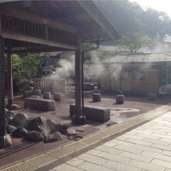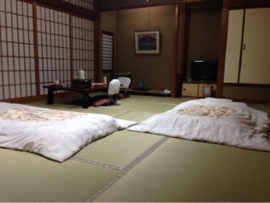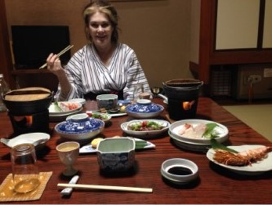Kinosaki-onsen – a Japanese Spa Town
Onsen: The Best Thing in Japan
Making good on my own rating that the onsen is the height of Japanese culture, Gerard and I went to Kinosaki-onsen, a charming spa town on a northwestern coast of the main island, Honshu. The word onsen is even in the name of the town. We did it up big: three nights, two-and-a-half days.
Onsen: Baths and Footbaths
There are seven onsen in Kinosaki-onsen open to tourists staying at a hotel in town. This number is two less than the nine golf courses available for golf lovers at Pinehurst, North Carolina.
Perhaps the onsen/golf course ratio can be improved by noting that Kinosaki-onsen has at least four public footbaths around town – and these were only the ones I happened to see. I’m sure there are more I didn’t notice.
Here I am at one. I could not actually get my feet in the water because it was boiling hot. So the feel of it was less like relaxation and more like torture.
The boiling water is natural. Here’s another angle on the footbath, which is in the bottom left foreground. You see the steam rising from a big wooden box-like structure in the middle left. The box contains a rock out of which the steam is pouring.
Here’s another footbath, drained and waiting to be filled for the new day.
And other one:
Onsen: Get Serious
Kinosaki-onsen is a place where you are serious about your baths. You plan them: one around 7:00 am when many onsen open up. This gets you clean before breakfast at 8:30. There may be another bath before lunch. A big time is 4:00 or 5:00 in the afternoon, when you see couples, whole families or groups of friends circulating in town, dressed in their yukata (dressing gown), choosing which bath to go to. Some people wear street clothes. However, most walk in their yukata, as pictured here.
The baths get crowded. So you have to scope and go to the ones with the biggest pools at the busiest time. I like the ones where there’s an outdoor pool.
After dinner, another bath. A couple of the onsen don’t close until midnight.
About a day and a half in to this bathing extravaganza, I noticed my fingernails got shiny. I’m not sure what minerals they put in the water, but even a few days later my fingernails remained shiny.
We stayed in a traditional hotel:
The main room/bedroom is very spare: just futons on the floor and a low table. The tatami mats on the floor are fragrant.
The shoji screen opens onto a small sitting area. Here’s Gerard at it:
In this area there is the bathroom, which only has a toilet. No need for tubs or showers in local hotels.
Onsen: Eat, Bathe. Sleep, Repeat
Our hotel was demi-pension, which meant we got both breakfast and dinner served to us in a private room. The spread all three nights and all three mornings was magnificent. There were little bowls of this and that, copious fish, rice dishes, pickled things, sauces, boiling pots with meat and mushrooms and the like.
So, this is what happens. Once you’re in town for a day or two, you end up seeing the same people in the street, and the inevitable thought crosses your mind, “Hey, I’ve seen that woman and her two kids naked.”
The next thought is, I imagine they might be thinking a similar thing when they see me.
Here’s a map of the seven baths:

Note: In my blog Ten Things to Love About Japanese Culture, I put the Japanese onsen (communal bath) as #1.
See: All My Japan Blogs
Categorised in: Adventure, East Asia, Japan
This post was written by Julie Tetel Andresen
You may also like these stories:
- google+
- comment












